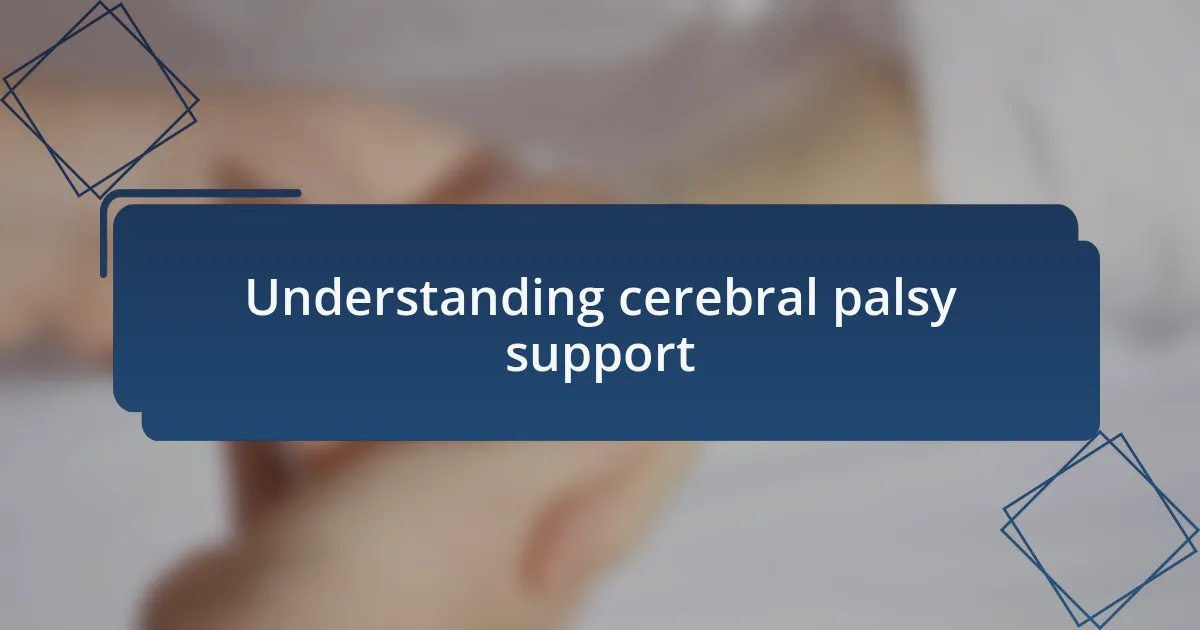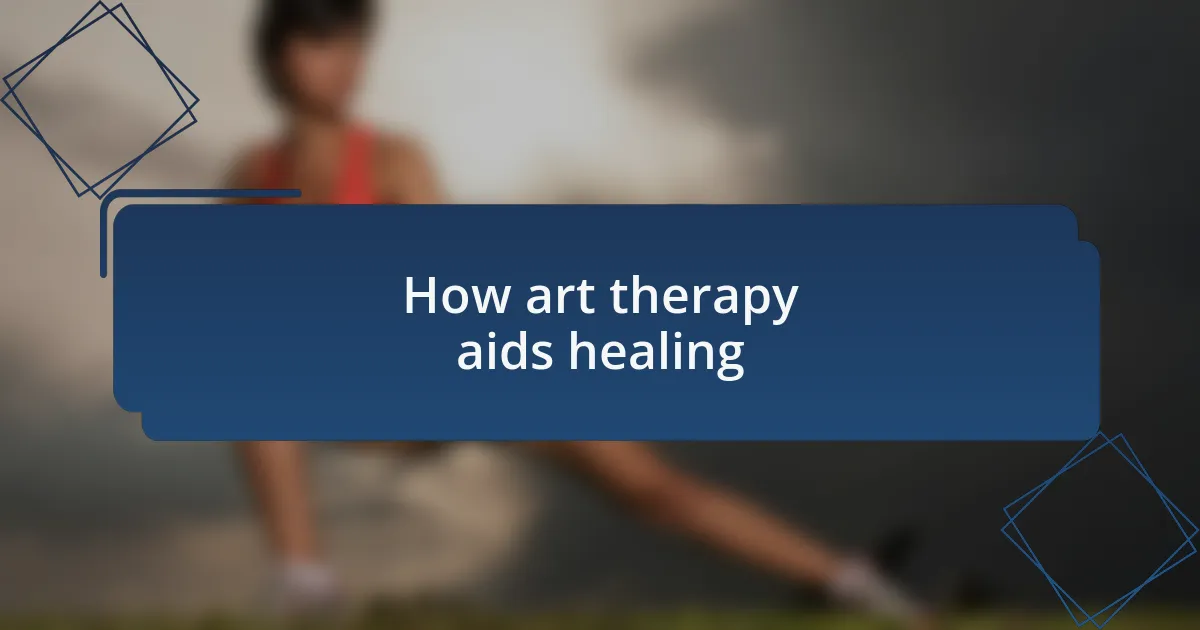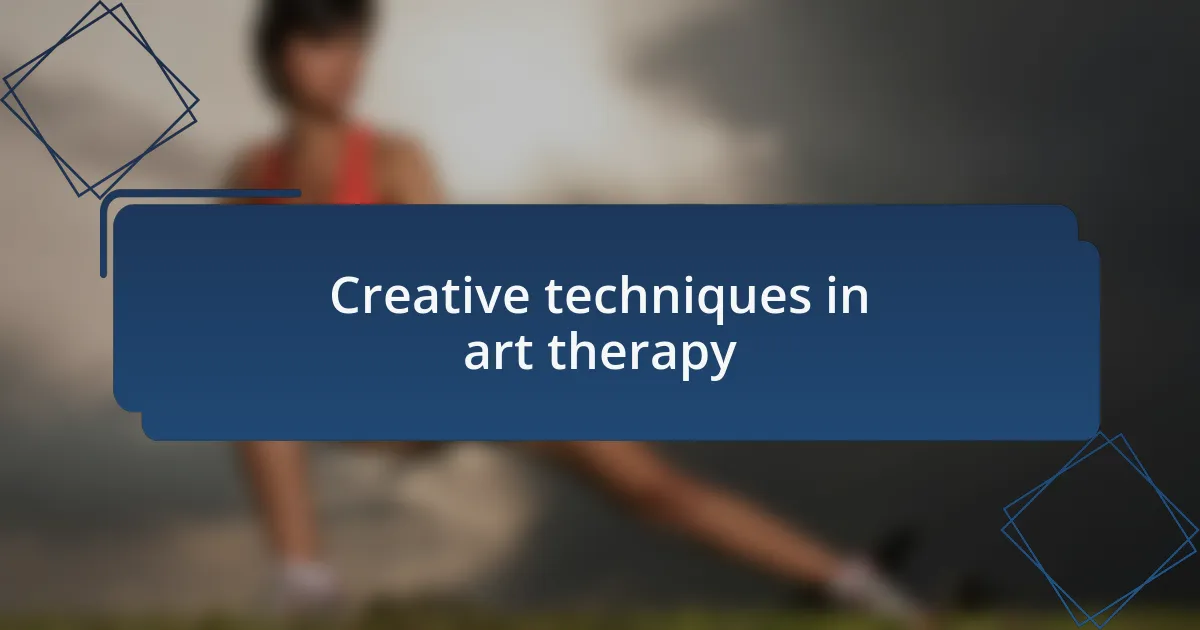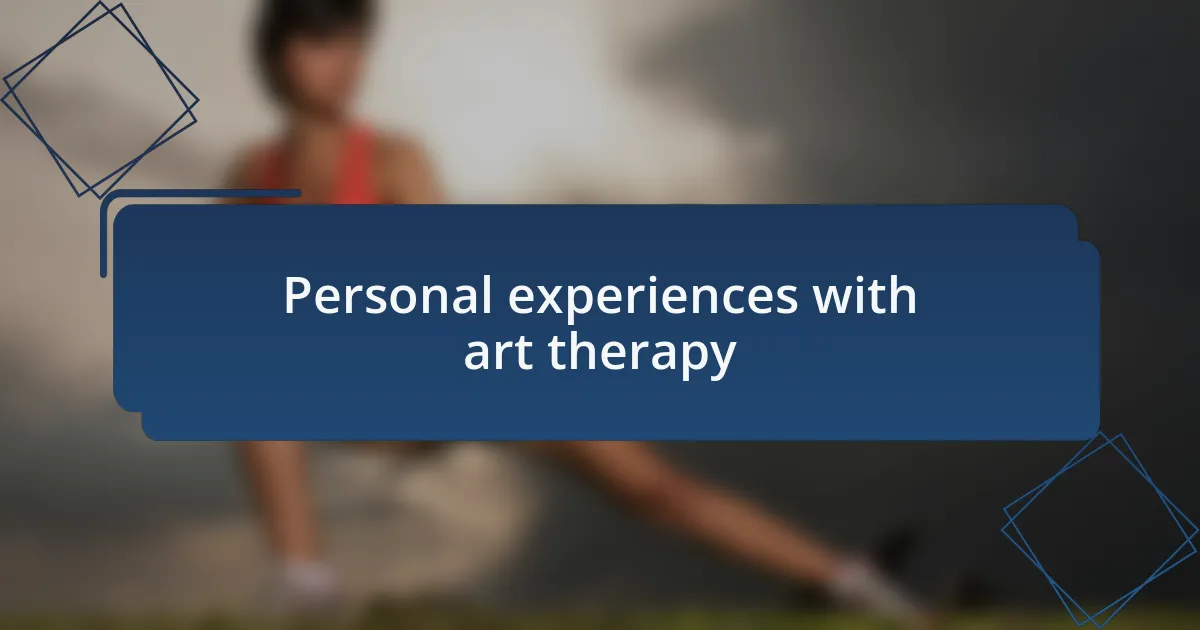Key takeaways:
- Cerebral palsy support fosters community and shared experiences, enhancing emotional well-being.
- Art therapy serves as a powerful tool for self-expression and emotional healing, allowing individuals to confront feelings through creative processes.
- Engaging techniques in art therapy, such as collage-making and mindfulness drawing, empower individuals to express emotions and navigate challenges.
- Personal experiences with art therapy reveal how creativity transforms pain into beauty and fosters connections through shared journeys.

Understanding cerebral palsy support
Cerebral palsy support encompasses various approaches tailored to meet the unique needs of individuals with this condition. I’ve often wondered how vital it is for each person to find the right kind of support that resonates with their journey. Having observed various support systems, I can say that the sense of community and shared experiences can dramatically enhance one’s emotional well-being.
Personal experiences with support groups have shown me the incredible power of connection. I vividly remember attending a local session where families shared not just the challenges, but also the small victories that kept us moving forward. How often do we underestimate the strength that comes from simply having someone who understands our journey?
Moreover, practical support, whether it be therapy, educational resources, or advocacy, is crucial for long-term development. In my experience, the right kind of support can bring out strengths I never knew existed within myself or my loved ones. Isn’t it fascinating how, when we surround ourselves with the right tools and people, we begin to see possibilities where there once were barriers?

What is art therapy
Art therapy is a therapeutic practice that uses creative expression to foster emotional healing and personal growth. I remember vividly the first time I picked up a paintbrush during a session; it felt liberating to translate my thoughts and feelings into something tangible. Through this process, I’ve learned that the act of creating can provide a safe space for self-exploration and healing.
This form of therapy is guided by trained professionals who help individuals use art as a means of communication, especially for those who may struggle to express emotion verbally. I often found that colors and shapes could convey my inner turmoil more effectively than words ever could. Isn’t it remarkable how art can bridge the gap when words fail?
One of the most profound aspects of art therapy is its ability to engage not just the mind, but the entire being. As I immersed myself in the creative process, I discovered layers of my emotions that I didn’t even know existed. It makes you wonder: how often do we overlook the power of creativity in navigating our emotions and experiences?

How art therapy aids healing
Art therapy aids healing by opening doors to emotions that often lie dormant. I remember one session when I spontaneously chose bright colors to depict an otherwise painful memory. The simplicity of that choice revealed so much about my state of mind; it was as if each stroke was pulling out feelings I didn’t know I had. This process can be incredibly cathartic, allowing individuals to confront and express their emotions in a way that feels safe and manageable.
What I’ve found fascinating is how art therapy encourages mindfulness. As I focused on the act of creating, my swirling thoughts settled, and I became anchored in the moment. This kind of presence can lead to a calming effect, helping to regulate emotions and reducing anxiety – something I’ve personally experienced when finding peace in the patterns of my artwork.
Moreover, the community aspect of art therapy shouldn’t be overlooked. Sharing creations with others in a group setting can foster a sense of belonging and validation. During one group session, I felt an overwhelming connection as we discussed our pieces; it was enlightening to witness how each person’s expression reflected their journey. Isn’t it amazing how sharing art can create such powerful bonds among people who have faced similar challenges?

My journey with cerebral palsy
Living with cerebral palsy has shaped my entire outlook on life. From a young age, I faced countless physical challenges, but I discovered that my experiences didn’t just limit me; they also fueled my creativity. I often find myself reflecting on moments of frustration, like when I struggled to participate in activities with my peers. Those moments taught me resilience, but they also ignited my passion for art as a means of expressing the frustrations that my words sometimes failed to capture.
There are times when I felt isolated, battling not only the physical limitations but also the emotional weight they carried. I clearly remember a day in school when I had difficulty navigating my surroundings while my classmates moved effortlessly. It was a painful realization, yet later that evening, I poured my feelings into a painting. I used dark hues to illustrate the struggle and lighter shades to symbolize hope. Isn’t it interesting how art can transform pain into beauty?
As I continued my journey with cerebral palsy, I found that my identity was closely intertwined with my artistic expression. I once had the opportunity to showcase my artwork at a local community event. The supportive feedback not only uplifted my spirit but also helped me embrace my journey more fully. In that moment, I realized that my experiences, both challenging and rewarding, could inspire others who might be facing similar battles. How powerful is it to connect through shared experiences, allowing art to be our voice?

Creative techniques in art therapy
Art therapy integrates various creative techniques that can be incredibly therapeutic. For instance, I remember a session where we used collage-making to express our feelings. As I sifted through magazines, it was liberating to assemble images and words that conveyed my emotions more effectively than I could articulate. There’s something deeply empowering about visually piecing together your narrative, isn’t there?
Another technique that resonated with me was mindfulness drawing. During one session, we were encouraged to focus solely on the act of drawing without expectations. I recall zoning in on the simple movements of my hand, the texture of the paper, and the colors blending together. This not only calmed my mind but also created a space to release the tension built from daily struggles. Have you ever experienced that soothing effect of engaging fully in a creative activity?
Additionally, I found that working with clay opened new avenues for expression. The tactile nature of shaping and molding allowed me to communicate feelings of frustration and joy simultaneously. I vividly remember making a sculpture that represented my journey—each curve and line symbolizing different challenges overcome. It’s fascinating how materials can become a physical representation of our inner worlds, don’t you agree?

Personal experiences with art therapy
Art therapy has brought me profound insights into my emotional landscape. I recall a group session where we painted our feelings. As I dipped my brush into the vibrant colors, it felt like I was pouring out everything that had been bottled up inside me. Each stroke became a channel for my unspoken thoughts—a joyful yellow splashed across my canvas perfectly captured a moment of elation, while a deep, stormy blue reflected my ongoing struggles. It’s remarkable how colors and shapes can give voice to emotions that often feel too complex to articulate, isn’t it?
During a particularly challenging week, I turned to art therapy as my refuge. One afternoon, I decided to create a mural that represented my journey with cerebral palsy. As I painted, memories surfaced—each brush of color representing a lesson learned or a mountain climbed. I found solace in knowing that my experiences weren’t just hurdles; they were part of a larger picture. Have you ever found that expressing yourself creatively can transform how you perceive your challenges?
I also discovered that integrating music into my art sessions made a world of difference. One evening, I played some calming tunes and began to sketch. The rhythm influenced my lines and shapes, making the act of drawing feel like a dance. It was as if I was tapping into a shared creativity, where the music connected my emotions to the movements of my pencil. This synergy reminded me that healing often comes when we allow ourselves to play and explore without judgment. Don’t you think that sometimes the best breakthroughs occur when we let go of our inhibitions?